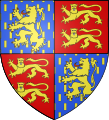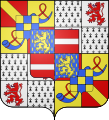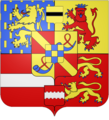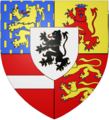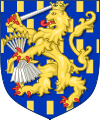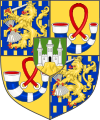- House of Orange-Nassau
-
House of Orange-Nassau 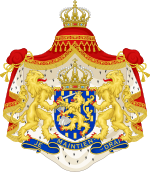
Royal Coat of arms of the NetherlandsCountry Netherlands, England, Scotland, Ireland, Luxembourg, Orange, Nassau Ancestral house House of Nassau Titles Count of Nassau-Dillenburg, Prince of Orange, Stadtholder of various provinces of the Dutch Republic, King of England, Scotland and Ireland, Princely Count of Nassau-Dietz, Fürst of Nassau-Orange, Fürst of Nassau-Orange-Fulda,
Duke of Limburg, Grand Duke of Luxembourg, 1815-1890
King or Queen of the Netherlands (main title),Founder William I of Orange (William the Silent) Current head Queen Beatrix of the Netherlands Founding 1544 Dissolution Since 1962 extinct in the original agnatic line The House of Orange-Nassau (in Dutch: Huis van Oranje-Nassau), a branch of the European House of Nassau, has played a central role in the political life of the Netherlands — and at times in Europe — since William I of Orange (also known as "William the Silent" and "Father of the Fatherland") organized the Dutch revolt against Spanish rule, which after the Eighty Years' War led to an independent Dutch state.
Several members of the house served during this war and after as governor or stadtholder (Dutch stadhouder). However, in 1815, after a long period as a republic, the Netherlands became a monarchy under the House of Orange-Nassau.
The dynasty was established as a result of the marriage of Hendrik III of Nassau-Breda from Germany and Claudia of Châlon-Orange from French Burgundy in 1515. Their son René inherited in 1530 the Principality of Orange from his mother's brother, Philibert of Châlon. As the first Nassau to be the Prince of Orange, René could have used "Orange-Nassau" as his new family name. However, his uncle, in his will, had stipulated that René should continue the use of the name Châlon-Orange. History knows him therefore as René of Châlon. After the death of René in 1544 his cousin William of Nassau-Dillenburg inherited all his lands. This "William I of Orange" - in English better known as William the Silent - became the founder of the House of Orange-Nassau.
The House of Nassau
 1544 - "Orange-Nassau" symbolized by adding the "Châlon-Orange" arms in an escutcheon to the "Nassau" arms
1544 - "Orange-Nassau" symbolized by adding the "Châlon-Orange" arms in an escutcheon to the "Nassau" arms
The castle of Nassau was founded around 1100 by Count Dudo-Henry of Laurenburg (German: Dudo-Heinrich von Laurenburg), the founder of the House of Nassau. In 1120, Dudo-Henry's sons and successors, Counts Robert I (German: Ruprecht; also translated Rupert) and Arnold I of Laurenburg, established themselves at Nassau Castle with its tower. They renovated and extended the castle complex in 1124.
The first man to be called the count of Nassau was Henry I, who lived in the first half of the 13th century. The Nassau family married into the family of the neighboring Counts of Arnstein (now Kloster Arnstein). His sons Walram and Otto split the Nassau possessions. The descendants of Walram became known as the Walram Line, which became Dukes of Nassau, and in 1890, the Grand Dukes of Luxembourg. The descendants of Otto became known as the Otton Line, which inherited parts of the Nassau county, properties in France, and in the Netherlands.
The House of Orange-Nassau stem from the Otton Line. The second person was Engelbert I, who offered his services to the Duke of Burgundy, married in 1403 the Dutch noblewoman Johanna van Polanen and so inherited lands in the Netherlands, with the barony of Breda as the core of the Dutch possessions & the family fortune.
The importance of the Nassaus grew throughout the 15th and 16th century. Hendrik III of Nassau-Breda was appointed stadtholder of Holland and Zeeland by Charles of Ghent in the beginning of the 16th century. Hendrik was succeeded by his son René of Châlon-Orange in 1538, who was, as his full name stated, the Prince of Orange. When René died prematurely on the battlefield in 1544 his possessions passed to his cousin, William I of Orange. From then on, the family members called themselves "Orange-Nassau."
See also Adolf of Germany
The Dutch rebellion
and
Although Charles V resisted the Protestant Reformation, he ruled the Dutch territories wisely with moderation and regard for local customs, and he did not persecute his Protestant subjects on a large scale. His son Philip II inherited his antipathy for the Protestants but not his moderation. Under the reign of Philip, a true persecution of Protestants was initiated and taxes were raised to an outrageous level. Discontent arose and William of Orange (with his vague Lutheran childhood) stood up for the Protestant (mainly Calvinist) inhabitants of the Netherlands. Things went badly after the Eighty Years' War started in 1568, but luck turned to his advantage when Protestant rebels attacking from the North Sea captured Brielle, a coastal town in present-day South Holland in 1572. Many cities in Holland began to support William. During the 1570s he had to defend his core territories in Holland several times, but in the 1580s the inland cities in Holland were secure. William of Orange was considered a threat to Spanish rule in the area and was assassinated in 1584 by a hired killer sent by Philip.
William was succeeded by his second son Maurits, a Protestant who proved an excellent military commander. His abilities as a commander and the lack of strong leadership in Spain after the death of Philip II (1598) gave Maurits excellent opportunities to conquer large parts of the present-day Dutch territory.
 "The Nassau Cavalcade", members of the house of Orange and Nassau on parade in 1621 from an engraving by Willem Delff. From left to right in the first row: Prince Maurice, Prince Philip William and Prince Frederick Henry.[1]
"The Nassau Cavalcade", members of the house of Orange and Nassau on parade in 1621 from an engraving by Willem Delff. From left to right in the first row: Prince Maurice, Prince Philip William and Prince Frederick Henry.[1]
In 1585 Maurits was elected stadtholder of the Provinces of Holland and Zealand as his father's successor and as a counterpose to Elizabeth's delegate, the Earl of Leicester. In 1587 he was appointed captain-general (military commander-in-chief) of the armies of the Dutch Republic. In the early years of the 17th century there arose quarrels between stadtholder and oligarchist regents — a group of powerful merchants led by Johan van Oldebarnevelt — because Maurits wanted more powers in the Republic. Maurits won this power struggle by arranging the judicial murder of Oldebarnevelt.
Expansion of dynastic power
Maurits died unmarried in 1625 and left no legitimate children. He was succeeded by his half-brother Frederick Henry (Dutch: Frederik Hendrik), youngest son of William I. Maurits urged his successor on his deathbed to marry as soon as possible. A few weeks after Maurits's death, he married Amalia van Solms-Braunfels. Frederick Henry and Amalia were the parents of a son and several daughters. These daughters were married to important noble houses such as the house of Hohenzollern, but also to the Frisian Nassaus, who were stadtholders in Friesland. His only son, William, married Mary, Princess Royal and Princess of Orange, the eldest daughter of Charles I of England. These dynastic moves were the work of Amalia.
Exile and resurgence
 Painting by Willem van Honthorst (1662), showing four generations of Princes of Orange: William I, Maurice and Frederick Henry, William II, and William III.
Painting by Willem van Honthorst (1662), showing four generations of Princes of Orange: William I, Maurice and Frederick Henry, William II, and William III.
Frederick Henry died in 1647 and his son succeeded him. As the Treaty of Munster was about to be signed, thereby ending the Eighty Years War, William tried to extend his powers beyond the military to make his function valuable at peace, at the great distress of the regents. When Andries Bicker and Cornelis de Graeff, the great regents of the city of Amsterdam refused some mayors he appointed, he besieged Amsterdam. The siege provoked the wrath of the regents. William died of smallpox on November 6, 1650, leaving only a posthumous son, William III (*November 14, 1650). Since there was no Prince of Orange upon the death of William II, the regents used this opportunity to leave the stadtholdership vacant. This inaugurated the era in Dutch history that is known as the First Stadtholderless Period. A quarrel about the education of the young prince arose between his mother and his grandmother Amalia (who outlived her husband by 28 years). Amalia wanted an education which was pointed at the resurgence of the House of Orange to power, but Mary wanted a pure English education. The Estates of Holland, under Jan de Witt and Cornelis de Graeff, meddled in the education and made William a "child of state" to be educated by the state. The doctrine used in this education was keeping William from the throne. William became indeed very docile to the wishes of the regents and the Estates.
The Dutch Republic was attacked by France and England in 1672. The military function of stadtholder was no longer superfluous, and with the support of the Orangists, William was restored, and he became the stadtholder as "William III". William successfully repelled the invasion and seized royal power. He became more powerful than his predecessors from the Eighty Years War. In 1677, William married his cousin Mary Stuart, the daughter of the future king James II of England. In 1688, William embarked on a mission to depose his Catholic father-in-law from the thrones of England, Scotland and Ireland. He and his wife were crowned the King and Queen of England on April 11, 1689. With the accession to the thrones of the three kingdoms, he became one of the most powerful sovereigns in Europe, and the only one to defeat Louis XIV of France. Many members of the House of Orange were devoted admirers of the King-Stadtholder afterwards. William III died childless after a riding accident on March 8, 1702, leaving the House of Orange extinct, and leaving Scotland, England and Ireland to his sister-in-law Queen Anne.
The second stadtholderless era
The regents found that they had suffered under the powerful leadership of King William III and declared the stadtholdership vacant for the second time. Since William III died childless in 1702 the principality became a matter of dispute between Prince John William Friso of Nassau-Dietz of the Frisian Nassaus and King Frederick I of Prussia, who both claimed the title Prince of Orange. Both descended from Frederick Henry, Prince of Orange. The King of Prussia was his grandson through his mother, Countess Luise Henriette of Nassau. Frederick Henry in his will had appointed this line as successor in the case the main House of Orange-Nassau would die out. John William Friso was a great-grandson of Frederick Henry and was appointed heir in William III's will. The principality was captured by the forces of King Louis XIV of France under François Adhémar de Monteil, Count of Grignan, in the Franco-Dutch War in 1672, and again in August 1682. With the Treaty of Utrecht that ended the wars of Louis XIV, the territory was finally ceded to France by Frederick I in 1713. The treaty also decided that both claimants and their descendents were allowed to bear the title. John William Friso drowned in 1711 in the Hollands Diep near Moerdijk, and he left his posthumously-born son Willem IV of Nassau. William IV was proclaimed the stadtholder of Guelders, Overijssel, Drenthe, and Utrecht in 1722. When the French invaded Holland in 1747, William IV was restored as the stadtholder of the entire Dutch Republic, hereditary in both the male and the female lines.
The end of the republic
William IV died in 1751, leaving his three-year-old son, Willem V of Orange, as the stadtholder. Since Willem V was still a minor, the regents reigned for him. He developed to be an indecisive person, a character defect which would follow Willem V for his whole life. His marriage to Wilhelmina of Prussia relieved this defect to some degree. In 1787, Willem V survived a coup by the Patriots (democratic revolutionaries) after the Kingdom of Prussia intervened. When the French invaded Holland in 1795, Willem V was forced to flee, and he was never to return to Holland.
After 1795, the House of Orange-Nassau faced a difficult period, surviving in exile at other European courts, especially those of Prussia and of England. In 1802 William V's son William VI unconditionally renounced the stadtholdership in return for a few territories from Napoleon Bonaparte (Treaty of Amiens).[2] Willem V died in 1806.
Dutch Royalty
House of Orange-Nassau
William I Children William II Prince Frederick Princess Paulina Marianne, Princess Albert of Prussia Grandchildren Louise, Queen of Sweden and Norway Prince William Prince Frederick Marie, Princess of Wied William II Children William III Prince Alexander Prince Henry Prince Ernest Casimir Sophie, Grand Duchess of Saxe-Weimar-Eisenach William III Children William, Prince of Orange Prince Maurice Alexander, Prince of Orange Wilhelmina Wilhelmina Children Juliana Juliana Children Beatrix Princess Irene Princess Margriet Princess Christina Beatrix Children Willem-Alexander, Prince of Orange Prince Friso Prince Constantijn Grandchildren Princess Catharina-Amalia Princess Alexia Princess Ariane Countess Luana Countess Zaria Countess Eloise Count Claus-Casimir Countess Leonore The Monarchy (since 1815)
A new spirit: the United Kingdom of the Netherlands
After a repressed Dutch rebel action, Prussian and Cossack troops drove out the French in 1813, with the support of the Patriots of 1785. Although most of the leaders were the same men who had driven out William V, it was virtually taken that any new government would have to be headed by his son, William VI, prince of Orange (known in Dutch as Willem Frederik). All agreed that it would be better in the long term for the Dutch to restore William themselves rather than have him imposed by the allies.
At the invitation of the provisional government, William VI returned to the Netherlands on November 30. This move was strongly supported by the United Kingdom, which sought ways to strengthen the Netherlands and deny future French aggressors easy access to the Low Countries' Channel ports. On December 6, William proclaimed himself hereditary sovereign prince of the Netherlands (having previously declined the offer of kingship considering a stadtholdership could give him more power). In 1814 the former Austrian Netherlands (now Belgium) was added to his realm. On March 15, 1815 with the support of the powers gathered at the Congress of Vienna, William proclaimed himself King William I. He was also made grand duke of Luxembourg, and the title 'Prince of Orange' was changed to 'Prince of Oranje'. The two countries remained separate despite sharing a common monarch.
As king of the United Kingdom of the Netherlands, William tried to establish one common culture. This provoked resistance in the southern parts of the country, which had been culturally separate from the north since 1581. He was considered an enlightened despot.
The Prince of Orange held rights to Nassau lands (Dillenburg, Dietz, Beilstein, Hadamar, Siegen) in central Germany. On the other hand the King of Prussia, Frederick William III--brother-in-law and first cousin of William I, had beginning from 1813 managed to establish his rule in Luxembourg, which he regarded as his inheritance from Anne, Duchess of Luxembourg who had died over three centuries earlier. At the Congress of Vienna, the two brothers-in-law agreed to a trade—Frederick William received William I's ancestral lands while William I received Luxembourg. Both got what was geographically nearer to their center of power.
In 1830 Belgium declared its independence and William fought a disastrous war until 1839 when he was forced to settle for peace. With his realm halved, he decided to abdicate in 1840. Royal power was curbed during the reign of his son William II in a constitution ordered by the King to prevent the Revolution of 1848 from spreading to his country.
William III and the threat of extinction
William II died in 1849. He was succeeded by his son, King William III, a rather conservative, even a reactionary man. William III was sharply opposed to the new 1848 constitution, and he continually tried to form his own royal governments. In 1868, he tried to sell Luxembourg to France, which was the source of a quarrel between Prussia and France.
William III had a rather unhappy marriage with Sophie of Württemberg, and his heirs died young. This raised the possibility of the extinction of the House of Orange-Nassau. After the death of Queen Sophie in 1877, William remarried, to Emma of Waldeck and Pyrmont in 1879. One year later, Queen Emma gave birth to their daughter and the royal heiress, Wilhelmina.
Since females were not allowed to hold power in Luxembourg, due to Salic law, Luxembourg passed to the House of Nassau-Weilburg, a collateral line to the House of Orange. The Dutch Royal Family faced the threat of a complete extinction until 1909, when Wilhemina gave birth to her daughter, Juliana. The Dutch royal house remained quite small until the latter 1930s and the early 1940s, during which Juliana gave birth to four children. Although the House of Orange died out in its male line with the death of Queen Wilhelmina, the name "Orange" continues to be used by the Dutch royalty.
A modern monarchy
Wilhelmina was queen of the Netherlands for 58 years, from 1890 to 1948. Because she was only 10 years old in 1890, her mother, Queen Emma, was the regent until Wilhelmina's 18th birthday in 1898. The Netherlands remained neutral in World War I, during her reign, and this country was not invaded by Germany, as neighboring Belgium was.
Nevertheless, Queen Wilhelmina became a symbol of the Dutch resistance during World War II. The moral authority of the Monarchy was restored because of her rule. After fifty years on the throne as the Queen, Wilhelmina decided to abdicate in favour of her daughter, Juliana. Juliana had the reputation of making the monarchy less "aloof", and under her reign the Monarchy became known as the "cycling monarchy". Members of the royal family were often seen bicycling through the cities and the countryside under Juliana.
A royal marriage policy quarrel occurred starting in 1966, when the future Queen Beatrix decided to marry Claus von Amsberg, a German diplomat. The marriage of a member of the royal family to a German was quite controversial in the Netherlands, which had suffered under Nazi German occupation in 1940 - 45. This reluctance to accept a German consort probably was exacerbated by von Amsberg's former membership in the Hitler Youth under the Nazi regime in his native country, and also his following service in the German Wehrmacht.
Permission was needed from the civilian government for Beatrix to marry anyone, but after some argument, it was granted. As the years went by, Prince Claus was fully accepted by the Dutch people. In time, he became one of the most popular members of the Dutch monarchy, and his death in 2002 was widely mourned.
On April 30, 1980, Queen Juliana abdicated in favor of her daughter, Beatrix. In the early years of the twenty-first century, the Dutch monarchy seems to be popular with a large part of the population. The first-born son of Beatrix and her husband, Prince Claus, Crown Prince Willem-Alexander, was born on April 27, 1967 - the first male heir to the Dutch throne in almost 100 years. Willem-Alexander married Máxima Zorreguieta in 2002. They are already the parents of three daughters: Catharina-Amalia, Alexia, and Ariane. When Beatrix of the Netherlands passes away, or abdicates the throne, the Crown Prince will take the throne, most likely as King William IV.
After a long struggle with neurological illiness, Queen Juliana died on March 20, 2004, and her husband, Prince Bernhard, died on December 1 of that same year.
The Royal Family and the Royal House
A distinction is made in the Netherlands between the royal family and the Royal House.
The royal family is the Orange-Nassau family. This includes people born into the family or who have married into the family. They are entitled to bear the title "prince or princess of Oranje-Nassau." However, not every member of which is a member of the Royal House, and entitled to bear the designation "prince or princess of the Netherlands". By Act of Parliament, the members of the Royal House are[3]:
- the monarch (King or Queen);
- the former monarch (on abdication);
- the members of the royal family in the line of succession to the throne;
- the spouses of the above.
Members of the Royal House can lose their membership and designation as prince or princess of the Netherlands if they marry without the consent of the Dutch Parliament. For example, this happened with Prince Friso when he married Mabel Wisse Smit. This is written down explicitly in the part of the constitution of the Netherlands that controls the Monarchy of the Netherlands.
Family Tree
The house of Orange and Nassau is traceable to the 10th century, and a detailed family tree can be found at [1]. A detailed family tree of the House of Orange-Nassau from the 15th century can be found on the Dutch Wikipedia at at Dutch monarchs family tree.
A summary family tree of the House of Orange-Nassau[3]from the joining of the house of Nassau-Breda/Dillenburg and the House of Châlon-Arlay to the end of the Dutch Republic. The family spawned many famous statesmen and generals, including two of the acknowledged "first captains of their age", Maurice of Nassau and the Marshal de Turenne.
The house of Orange-Nassau was relatively unlucky in establishing a hereditary dynasty in an age that favoured hereditary rule. The Stuarts and the Bourbons came to power at the same time as the Oranges, and the Vasas were able to establish a hereditary kingship in Sweden. The House of Orange was no less gifted than those houses, in fact, some might argue more so, as their ranks included some the foremost statesmen and captains of the time. Although the institutions of the United Provinces became more republican and entrenched as time went on, William the Silent had been offered the countship of Holland and Zealand, and only his assassination prevented his accession to those offices. This fact did not go unforgotten by his successors.[4]
The Prince of Orange was also not just another noble among equals in the Netherlands. First, he was the traditional leader of the nation in war and in rebellion against Spain. He was uniquely able to transcend the local issues of the cities, towns and provinces. He was also a soveriegn ruler in his own right (see Prince of Orange article). This gave him a great deal of prestige, even in a republic. He was the center of a real court like the Stuarts and Bourbons, French speaking, and extravagant to a scale. It was natural for foreign ambassadors and dignitaries to present themselves to him and consult with him as well as to the States General to which they were officially credited. The marriage policy of the princes, allying themselves twice with the Royal Stuarts, also gave them acceptance into the royal caste of rulers.[5]
Besides showing the relationships among the family, the tree above then also points out an extraordinary run of bad luck. In the 211 years from the death of William the Silent to the conquest by France, there was only one time that a son directly succeeded his father as Prince of Orange, Stadholder and Captain-General without a minority (William II). When the Oranges were in power, they also tended to settle for the actualities of power, rather than the appearances, which increasingly tended to upset the ruling regents of the towns and cities. On being offered the dukedom of Gelderland by the States of that province, William III let the offer lapse as liable to raise too much opposition in the other provinces.[5]:75–83
In 1814, William VI of Orange became King of the Netherlands. The institution of the monarch in the Netherlands is considered an office under the Dutch Constitution. There are none of the religious connotations to the office as in some other monarchies. A Dutch sovereign is inaugurated rather than crowned/"coronated". It was initially more of a crowned/hereditary presidency, and a continuation of the status quo ante of the pre-1795 hereditary stadholderate in the republic. In practice today, the monarch has considerably less power. This summary genealogical tree shows how the now Royal house of Orange-Nassau is related[3]:
Arms
The gallery below show the coats of arms used by members of the house of Orange-Nassau. Their growing complexity and use of crowns shows how arms are used to reflect the growing political position and royal aspirations of the family. A much more complete armorial is given at the Armorial de la Maison de Nassau, section Lignée Ottonienne at the French Wikipedia, and another one at Wapen van Nassau, Tak van Otto at the Dutch Wikipedia.
The ancestral coat of arms of the Ottonian line of the house of Nassau is shown below. Their distant cousins of the Walramian line added a red coronet to distinguish them. The fact that these were arms were very similar to those of the counts of Burgundy (Franche-Comté) did not seem to cause too much confusion.
Henry III of Nassau-Breda came to the Netherlands in 1499 as heir to his uncle, Engelbrecht II of Nassau-Breda. His and his uncle's arms are shown below. When Philbert, prince of Orange died in 1530, his sister's son René of Breda inherited the Princedom of Orange on condition that he used the name and coat of arms of the Châlon-Orange family. History knows him therefore as René of Châlon instead of as "René of Nassau-Breda." The 1st and 4th grand quarters show the arms of the Chalons-Arlay (the gold bend) princes of Orange (the bugle). The blue and gold cross is the arms of Jeanne of Geneva, who married one of the Chalons princes. The 2nd and 3rd show the quarterings of Brittany and Luxembourg-St. Pol. The inescutcheon overall is his paternal arms quarterd of Nassau and Breda.[8] William the Silent's father, William the Rich, was rich only in children. He bore the arms shown below. Clockwise from upper left they displayed the arms of Nassau (1st quarter), Katzenelenbogen (3rd quarter), Dietz (2nd quarter), Vianden (4th quarter).
The princes of Orange in the 16th and 17th century used the following sets of arms. On becoming prince of Orange, William placed the Châlon-Arlay arms in the center ("as an inescutcheon") of his father's arms. He used these arms until 1582 when he purchased the marquisate of Veere and Vlissingen. It had been the property of Philip II since 1567, but had fallen into arrears to the province. In 1580 the Court of Holland ordered it sold. William bought it as it gave him two more votes in the States of Zeeland. He owned the government of the two towns, and so could appoint their magistrates. He already had one as First Noble for Philip William, who had inherited Maartensdijk. This made William the predominant member of the States of Zeeland. It was a smaller version of the countship of Zeeland (& Holland) promised to William, and was a potent political base for his descendants. William then added the shield of Veere and Buren to his arms as shown in the arms of Frederick Henry, William II and William III with the arms of the marquisate in the top center, and the arms of the county of Buren in the bottom center. William also started the tradition of keeping the number of billets in the upper left quarter for Nassau at 17 to symbolize the original 17 provinces of the Burgundian/Habsburg Netherlands, which he always hoped would form one united nation.[4]
-
Coat of arms of William the Silent as Prince of Orange from 1544 to 1582, and his eldest son Philip William[7]
-
The coat of arms used by Frederick Henry, William II, and William III as Prince of Orange[7]
-
An alternate coat of arms sometimes used by Frederick Henry, William II, and William III as Prince of Orange showing the county of Moers in the top center rather than Veere.[11]
The princes of Orange also had personal arms before they became reigning prince. Maurice never changed his as he rarely used the tile of "Prince of Orange". Some others are:
-
Personal arms of Frederick Henry before becoming Prince of Orange. At the center is his mother's arms of Coligny.
The main house of Orange-Nassau also spawned several illegitimate branches. These branches contributed to the political and economic history of England and the Netherlands. Louis of Nassau, Lord of De Lek and Beverweerd was a younger illegitimate son of Prince Maurice and Margaretha van Mechelen. His descendants were Counts of Nassau-LaLecq. One of his sons was the famous general Henry de Nassau, Lord of Overkirk, King William III's Master of the Horse, and one of the most trusted generals of John Churchill, 1st Duke of Marlborough. His descendants became the Earls of Grantham in England. Frederick van Nassau, Lord of Zuylestein, an illegitimate son of Frederick Henry, Prince of Orange, gave rise to the Earls of Rochford in England. The 4th earl of Rochford was a famous English diplomat and a statesman.
The house of Orange-Nassau also had many younger branches in the 16th, 17th and 18th centuries descended from William the Silent's younger brother Count John of Nassau-Dillenburg. One of which, the Nassau-Dietz branch in the 17th century, succeeded to the Dutch title of prince of Orange and the stadholderate in the 18th century. The arms are:[12]
-
Arms of the counts, later princes of Nassau-Dietz. They were usually elected stadholders of Friesland, and sometimes Groningen. They gave rise to the kings of the Netherlands. The center shield shows Limburg-Styrum, with the county of Limburg in the 1st quarter, and then clockwise the lordships of Bronkhorst, Borculo, and Wisch.
When the princes of Orange fled the Netherlands during the Batavian Republic and the Kingdom of Holland, and when France occupied the Netherlands, they were compensated by Napoleon with the Principality of Nassau-Orange-Fulda. These principalities were confiscated when Napoleon invaded Germany (1806) and William VI supported his Prussian relatives. He succeeded his father as prince of Orange later that year, after William V's death.
-
Arms of William VI of Orange as prince of Orange-Nassau-Fulda. The bottom most shield shows clockwise from top left the principality of Fulda, the lordship of Corvey, the county of Weingarten, and the lordship of Dortmund.[12]
When William VI of Orange returned to the Netherlands in 1813 and was proclaimed Sovereign Prince of the Netherlands, he quartered the former Arms of the Dutch Republic (1st and 4th quarter) with the "Châlon-Orange" arms (2nd and 3rd quarter), which had come to symbolize Orange. As an inescutcheon he placed his ancestral arms of Nassau. When he became King in 1815, he combined the Dutch Republic Lion with the billets of the Nassau arms and added a royal crown. In 1907, Queen Wilhelmina replaced the royal crown on the arms with a coronet.
-
Arms of the States-General of the Dutch Republic. The sword symbolizes the determination to defend the nation, and the bundle of 7 arrows the unity of the 7 United Provinces of the Dutch Republic.
-
Arms of William VI as sovereign prince of the Netherlands.[7]
-
First arms of the Kingdom and Kings of the Netherlands from 1815-1907.[3]
-
Arms of the Kingdom and Kings of the Netherlands since 1907.[3]
Wilhelmina further decreted that in perpetuit her descendants should be styled "princes and princesses of Orange-Nassau" and that the name of the house would be "Orange-Nassau" (in Dutch "Oranje-Nassau". Only those members of the members of the Dutch Royal House that are part of the smaller "Royal Family" can use the title of prince or princess of the Netherlands.[3] Since then, individual members of the House of Orange-Nassau are also given their own arms by the reigning monarch, similar to the United Kingdom. This is usually the royal arms, quartered with the arms of the principality of Orange, and an inescutcheon of their paternal arms.
-
Personal coat of arms of William Alexander and his brothers. [3]
-
Personal arms of Juliana. The inescutcheon is his father's arms of Mecklenburg. [3]
-
Personal arms of Beatrix and her sisters. The inescutcheon is their father's arms of Lippe. [3]
-
Personal Arms of the children of princess Margriet of the Netherlands (Princes Maurice, Bernhard, Floris and Pieter-Christian). The inescutcheon is their father's arms of van Vollenhoven. [3]
Standards
The Dutch Royal Family also makes extensive use of royal standards that are based on their coats of arms, but not identical to them (as the British Royal Family does). Some examples from the Royal Family's website are:[3]
The standards of the ruling king or queen:
The standards of the current sons of Queen Beatrix and their wives and the Queen's husband:
The standards of the sisters of Queen Beatrix and their children:
The standards of former members of the Royal Family:
See also
- Dutch monarchy
- House of Nassau
- Prince of Orange
- Orange Institution
- William III of England
References
- ^ Delff, Willem Jacobsz.. "De Nassauische Cavalcade". From an engraving on exhibit in the Rijksmuseum, Amsterdam. Rijksmuseum, Amsterdam. http://www.rijksmuseum.nl. Retrieved 26 April 2011.
- ^ He acquired Fulda, Corvey, Weingarten and Dortmund. He lost the possessions again after changing sides from France to Prussia in 1806. Cf. J. and A. Romein 'Erflaters van onze beschaving', Querido, 1979
- ^ a b c d e f g h i j k "The Official Website of the Dutch Royal House in English". http://www.koninklijkhuis.nl/english/. Retrieved 26 April 2011.
- ^ a b Rowen, Herbert H. (1988). The princes of Orange: the stadholders in the Dutch Republic. Cambridge University Press.
- ^ a b c Haley, K(enneth) H(arold) D(obson) (1972). The Dutch in the Seventeenth Century. Thames and Hudson. pp. 75–83. ISBN 0155184733.
- ^ Rietstap, Johannes Baptist (2003). Armorial general. vol.2. Genealogical Publishing Co.. p. 297. ISBN 0806348119.
- ^ a b c d e f g h i j Rietstap, Johannes Baptist (2003). Armorial general. vol.2. Genealogical Publishing Co.. p. 297. ISBN 0806348119.
- ^ Grew, Marion Ethel (1947). The House of Orange. 36 Essex Street, Strand, London W.C.2: Methuen & Co. Ltd.
- ^ Anonymous. "Wapenbord van Prins Maurits met het devies van de Engelse orde van de Kouseband". Exhibit of a painted woodcut of Maurice's Arms encircled by the Order of the Garter in the Rijksmuseum, Amsterdam. Rijksmuseum, Amsterdam. http://www.rijksmuseum.nl/collectie/zoeken/asset.jsp?id=NG-NM-10152&lang=en. Retrieved 26 April 2011.
- ^ Rietstap, Johannes Baptist (1861). Armorial général, contenant la description des armoiries des familles nobles et patriciennes de l'Europe: précédé d'un dictionnaire des termes du blason. G.B. van Goor. p. 746. "a la exception de celebre prince Maurice qui portai les armes ..."
- ^ Post, Pieter (1651). "Coat of Arms as depicted in "Begraeffenisse van syne hoogheyt Frederick Hendrick"". engraving, in the collection of. Rijksmuseum, Amsterdam. http://www.rijksmuseum.nl/collectie/zoeken/asset.jsp?id=NG-793-53. Retrieved 1 June 2011.
- ^ a b Rietstap, Johannes Baptist (1861). Armorial général, contenant la description des armoiries des familles nobles et patriciennes de l'Europe: précédé d'un dictionnaire des termes du blason. G.B. van Goor. p. 746.
Literature
- Herbert H. Rowen, The princes of Orange: the stadholders in the Dutch Republic. Cambridge and New York: Cambridge University Press, 1988.
- John Lothrop Motley, "The Rise of the Dutch Republic". New York: Harper & Brothers, 1855.
- John Lothrop Motley, "History of the United Netherlands from the Death of William the Silent to the Synod of Dort". London: John Murray, 1860.
- John Lothrop Motley, "The Life and Death of John of Barenvelt". New York & London: Harper and Brothers Publishing, 1900.
- Petrus Johannes Blok, "History of the people of the Netherlands". New York: G. P. Putnam's sons, 1898.
- Jonathan I. Israel, "The Dutch Republic: Its Rise, Greatness, and Fall, 1477–1806" Oxford University Press, 1995. ISBN 0-19-820734-4
- Pieter Geyl, "Orange and Stuart 1641-1672" Phoenix Press, 2002>
External links
- Dutch Royal House – official website
— Royal house —House of Orange-NassauVacant Title last held byHouse of Habsburg-Lorraine
as ruling house of the Duchy of LuxembourgRuling house of Luxembourg
1815–1890Succeeded by
House of Nassau-WeilburgVacant Title last held byHouse of Bonaparte
as ruling house of the Kingdom of HollandRuling house of the Netherlands
1815–Succeeded by
IncumbentCategories:- Dutch monarchy
- Dutch noble families
- European royal families
- German noble families
- History of the Netherlands
- House of Lippe
- House of Mecklenburg-Schwerin
- House of Nassau
- House of Orange-Nassau
Wikimedia Foundation. 2010.




